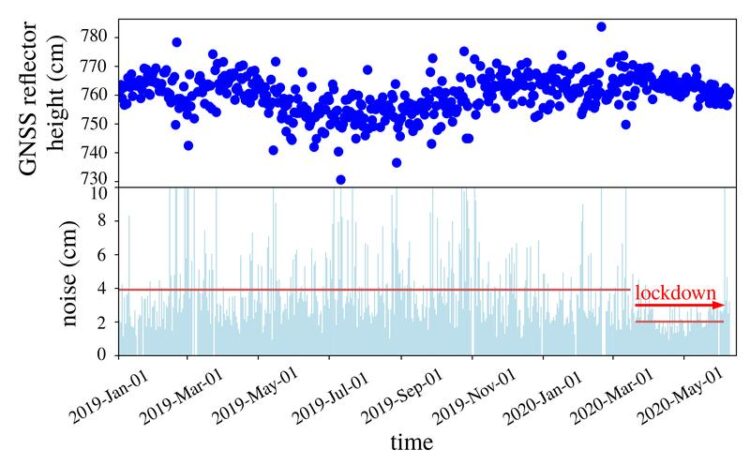Flood risks: More accurate data thanks to Covid-19

A geodetic GPS sensor obtains more precise measures of antenna height due to absence of cars in the neighboring parking lot during the lockdown.
© Makan A. Karegar
Emerging use of Global Navigation Satellite System (GNSS) makes it possible to continuously measure shallow changes in elevation of Earth surface. A study by the University of Bonn now shows that the quality of these measurements may have improved significantly during the pandemic, at least at some stations. The results show which factors should be considered in the future when installing GPS antennas. More precise geodetic data are important for assessing flood risks and for improving earthquake early warning systems. The journal “Geophysical Research Letters” now reports on this.
A number of countries went into politically decreed late hibernation at the onset of the Covid-19 pandemic. Many of those affected by the lockdown suffered negative economic and social consequences. Geodesy, a branch of the Earth Science to study Earth’s gravity field and its shape, on the other hand, has benefited from the drastic reduction in human activity. At least that is what the study now published in the Geophysical Research Letters shows. The study, which was carried out by geodesists from the University of Bonn, investigated the location of a precise GNSS antenna in Boston (Massachusetts) as an example.
GNSS receivers can determine their positions to an accuracy of a few mm. They do this using the US GPS satellites and their Russian counterparts, GLONASS. For some years now, it has also been possible to measure the distance between the antenna and the ground surface using a new method. “This has recently allowed our research group to measure elevation changes in the uppermost of soil layers, without installing additional equipment,” explains Dr. Makan Karegar from the Institute of Geodesy and Geoinformation at the University of Bonn. Researchers, for instance, can measure the wave-like propagation of an earthquake and the rise or fall of a coastal area.
The measuring method is based on the fact that the antenna does not only pick up the direct satellite signal. Part of the signal is reflected by the nearby environment and objects and reaches the GNSS antenna with some delays. This reflected part therefore travels a longer path to the antenna. When superimposed on the directly received signal, it forms certain patterns called interference. The can be used to calculate the distance between the antenna and the ground surface which can change over time. To calculate the risk of flooding in low-elevation coastal areas, it is important to know this change – and thus the subsidence of the Earth surface – precisely.
This method works well if the surrounding ground is flat, like the surface of a mirror. “But many GNSS receivers are mounted on buildings in cities or in industrial zones,” explains Prof. Dr. Jürgen Kusche. “And they are often surrounded by large parking lots – as is the case with the antenna we investigated in Boston.”
Cars cause disturbance
In their analysis, the researchers were able to show that parked cars significantly reduce the quality of the elevation data: Parked vehicles scatter the satellite signal and cause it to be reflected several times before it reaches the antenna, like a cracked mirror. This not only reduces the signal intensity, but also the information that can be extracted from it: It’s “noisy.” In addition, because the “pattern” of parked cars changes from day to day, these data can not be easily corrected.
“Before the pandemic, measurements of antenna height had an average accuracy of about four centimeters due to the higher level of noise,” says Karegar. “During the lockdown, however, there were almost no vehicles parked in the vicinity of the antenna; this improved the accuracy to about two centimeters.” A decisive leap: The more reliable the values, the smaller the elevation fluctuations that can be detected in the upper soil layers.
In the past, GNSS stations were preferably installed in sparsely populated regions, but this has changed in recent years. “Precise GNSS sensors are often installed in urban areas to support positioning services for engineering and surveying applications, and eventually for scientific applications such as deformation studies and natural hazards assessment,” says Karegar. “Our study recommends that we should try to avoid installation of GNNS sensors next to parking lots.”
Wissenschaftliche Ansprechpartner:
Dr. Makan Karegar
Institut für Geodäsie der Universität Bonn
Tel. +49 (0)228/73-6160
E-mail: karegar@uni-bonn.de
Originalpublikation:
Makan A. Karegar and Jürgen Kusche: Imprints of COVID-19 lockdown on GNSS observations: An initial demonstration using GNSS interferometric reflectometry, Geophysical Research Letters; DOI: 10.1029/2020GL089647
Media Contact
All latest news from the category: Earth Sciences
Earth Sciences (also referred to as Geosciences), which deals with basic issues surrounding our planet, plays a vital role in the area of energy and raw materials supply.
Earth Sciences comprises subjects such as geology, geography, geological informatics, paleontology, mineralogy, petrography, crystallography, geophysics, geodesy, glaciology, cartography, photogrammetry, meteorology and seismology, early-warning systems, earthquake research and polar research.
Newest articles

Self-Destructing Cancer Cells: Cutting-Edge RNA Breakthrough
Jülich scientists use novel RNA technology to selectively switch off tumours in the brain. An Adaptable Platform Technology That Destroys Glioblastoma Cancer Cells Using a special RNA molecule, a team…

Endurance Training: Transforming Lives of Heart Failure Patients
Can strength and endurance training be beneficial for patients with a certain form of heart failure? A research team from Greifswald investigated this question together with seven other research centers…

A Wake-Up Call for Mediterranean Shark Protection Against Extinction
Overfishing, illegal fishing and increasing marketing of shark meat pose significant threats to the more than 80 species of sharks and rays that inhabit the Mediterranean Sea, according to a…



